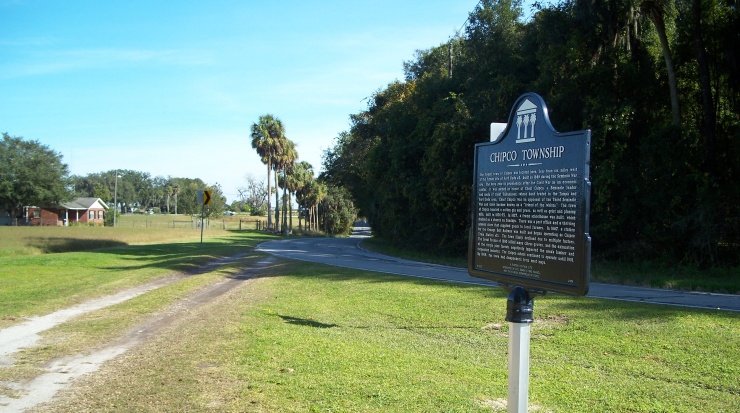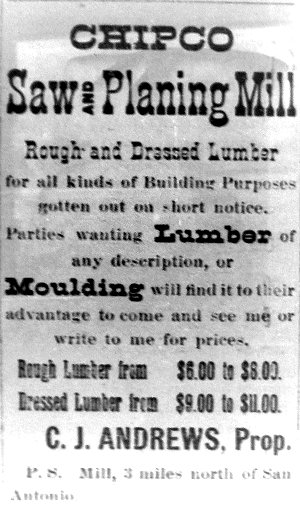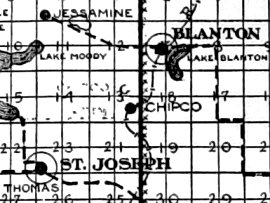HISTORY OF PASCO COUNTYChipco Information on the Oakdale School is here. Chipco (1963)
This article appeared in the Dade City Banner on April 25, 1963. Traveling along Memory Lane the History and Archives Committee of the Pioneer Florida Museum Assn. found a “lost community called Chipco.” It received its name, no doubt, from a tribe of Cow Creek Indians whose Chief was Chipco. These Indians took refuge before the 1850’s in cypress territory and roamed the wilds in search of food which consisted of wild hogs, bears, alligators, and berries. Chief Chipco was the central figure and many thrilling tales are told of tribal legends such as the “Green Corn Dance,” and stories handed down by the ancients long gone to their Happy Hunting ground (the Indian conception of heaven). Chief Chipco lived to a ripe old age — over 90 years old. Before his death, he chose Tallahassee, his nephew, to succeed him as Chief. Unlike many Indians, Chipco was friendly to the white man. There are many lost towns in Pasco County and Chipco is one of them. It has now merged into Blanton, St. Joseph, and Fort Dade in Township 24, Range 20. It wasn’t a town in a modern sense of the word, but a territory from Blanton to Clear Lake and from Ft. Dade to Stake Pond (now Lake Iola). It was bounded partly by a southern part of Blanton Lake, and then on by Mt. Zion to Ford Dade. Perhaps the Gants and Osborns were the first settlers to come to this region. The Gants built a grist mill operated by water power. It was the first in this county. Added a little later was the first cotton gin and press. This grist mill was a life-line for families for some distance. Farmers would bring their corn in the fall and winter to be ground into meal and grits, giving the mill owner one-eighth, by measure, for toll (the price of grinding). The mill was operated by J. J. Howell, and later the mill was sold to Fortner. The Hudsons came, but thought it unhealthy, perhaps because of malaria. Malaria was associated with marshes or swamps. It was believed that in such places a mysterious kind of air, or vapor, caused malaria attacks. It seems early settlers knew quinine would ward off malaria, but in the 20th century, particularly during and following World War I, folks began to accept the knowledge of doctors and scientists that their enemy was the mosquito. This caused many folks to move elsewhere, among them being the Hudsons, who moved to the Gulf Coast to what is now known as the city of Hudson. The Bischoffs, A. A. Bankston, Howe Sauter, Faulk, Howell, Levi Eiland, Jack Jackson, Nathes, and Dr. Hill came, whose living near was a great comfort. No one could ever know how many lives were spared because of him. The Orange Belt railroad was built in this area in 1887 and a box car was erected for a depot. The railroad caused a change in life of the community. There were wood-racks along the tracks giving revenue to settlers furnishing fat-wood for trains. Also they were an accommodation to the neighborhood. If you waited along the track you might be picked up and carried to the next rack. Then you could be returned home, if not in too big a hurry, by the next train. The schedules were very uncertain. A store was built and a post office was established. Mr. Hack operated a saw mill to the west. Schools serving the area in 1877 and earlier were Brushy Branch to the west, with J. S. Jackson, Johh W. Platt, and W. S. Holton as trustees; Ft. Dade Academy to the east with Alex Sumner, N. A. Carter, W. L. Mobley as trustees; and Spring Valley to the north, with C. C. Gant, W. L. Osborn and J. M. O’Berry as trustees. There was now a need for a school. A frame house was built beside the country road opposite the J. N. Nathe home with lumber donated by Mr. Hack. The little school was called Oak Dale and later Chipco and was in operation until 1901 when it merged with Blanton, and in 1905 was sold to the highest bidder for $13. To hear some senior citizens talk now, its value could not be estimated. Mr. Burnside remembers going there to Sunday School, as religious services were also held in the school. Mrs. Hack was his first Sunday School teacher. The Bischoff family, out of Boston, did not fit into the crude life but left their imprint by introducing the first Christmas tree to their neighbors. Some say it was the first Christmas tree in Florida. The Nathe family, children, and grandchildren were very contented with this countryside, all building homes nearby, and with the help of others established the community of St. Joseph. There are a few families left. The beautiful Hack house belonging now to the Jerry Hunts. The old trees around it help to tell their age. Close by is the C. J. Nathe home. Most all the land is now used for pasture and orange groves. Surely in its day it was a beautiful country with its thick hammocks, springs, high hills covered with large pines and many birds and wild animals. Most of the old folks lived their lives here in Chipco and left families to carry on their work. Chipco is no more, but memories linger on. Any comments or information about early history of Pasco county will be appreciated. Write P. O. Box 335, Attention History and Archives Committee, Dade City, Fla.  Chipco Items (1884)This article appeared in the Fort Dade Messenger on July 11, 1884. Thanks to Julie Billedo for providing this newspaper. The Stars and Stripes wave at Chipco. It was not the handiwork of nature, but of the good ladies of Chipco. We were never treated better, nor oftener, in or lives, than we were at Chipco on the fourth. Some of the citizens of Chipco went to the San Antonio celebration and we guess had a nice time, but still ours was a grand success. Chipco never fails. C. C. Gant has a splendid assortment of every thing found in a general store, he also has a rushing trade; he is going to advertise in the MESSENGER next week, and then I’ll bet my share of all the grits in Florida that he has to employ a clerk. We will soon have a saw and planing mill at this place; our old friend Hack will operate them and will do it just right too. Messrs. Faulk & Bankston have sold out their entire stock of goods to Michel Jones. Success to you friend J. You will do well if you will only advertise in the MESSENGER. The grist mill of C. C. Gant will soon be in operation; it is being repaired by Mr. Lee. Chipco will give another entertainment in the near future, for the benefit of a Union Church and School House to be built at the place. Quite a number of ladies and gentlemen passed through Chipco Friday Eve. All right Toney I will get even with you on the cigar question. The Fourth of July Celebration at Chipco (1884)This article appeared in the Fort Dade Messenger on July 11, 1884. We left Fort Dade on the morning of the 4th for Chipco, and as nothing of any consequence happened on the way, we will say nothing of our six mile journey. We arrived safely at the beautiful little town at an early hour and found the liberty loving people assembled neath the moss draped oaks and pines admiring the Stars and Stripes that floated in (?) the gentle breeze, reminding us that we had assembled to celebrate one hundred and eight anniversary of American Independence. Rome sat upon her Seven Hills of Beauty, but Chipco sits on a Single Hill of Beauty, surrounded by picturesque scenery. To the north east winds a range of hills which shows that Chipco could equal Rome as far as hills are concerned. Around about the border to the north of the city, the stately pine awaits the woodman’s axe. To the south we see a dense hammock on which cling the wild grape vines, and the sweet scented jessamine are hung with long flowing moss. Southwest we see the silvery lake, fed by numerous sparkling streams from the surrounding hills. While we stand and behold the lake, the mill, and the hills that surround, and from the highest point of the city we see the flag of the union, as she floats triumphantly in the pure air of freedom, with liberty and justice, inscribed upon its folds. The song bird sings gentle, nature murmurs, and the eternal hills seem to echo the word Liberty, scions of the past rise before us and the gentle breeze of liberty fans our cheeks as it did our forefathers. By 10 o’clock the people had assembled. The exercise opened with a song by Miss Jesse Wolton “Red White and Blue,” and prayer by Rev. A. M. C. Russell. He was then introduced to the audience, and for one hour and a half he held their close attention. His remarks were made on the progress of science and religion since our country had thrown off her yoke of bondage, and become a free and independent government. He spoke of freedom and of many discoveries that had been made. He compared the old time sickle to the self (?) binding reaper of the present day. The advancement we had made in conveying news from point to point, spoke of telegraphy, telephones, compared the present engine to the ancient horse mill and many other things that pleased as well as amusing the people. Mr. J. A. Hendley was introduced. His remarks were made on the progress of the government. He said that history was filled with examples, all of the nations that had passed away was but a warning that no government founded upon anything except justice and liberty can stand; that the idea of liberty was perpetuating all nations and causing the mightiest throne of the earth to tremble; he spoke of the courage and wisdom of our forefathers, how they had fought and founded a union that the sword and pen combined could not dismember. He dwelt for a moment on the dark days of the revolution and paid a tribute to the boys in gray who fought for a cause they believed to be just and true, and died beneath the flag that is now furled forever on the silent shores. Mr. Jeff Sumner of Oxford, Ga., was introduced. He made a few brief remarks in regard to our country. He said that no country could boast of better people and more rapid improvement than South Florida. Mr. Sumner although young carried us back in history to the dark days of other countries as well as his native home. His remarks were well received by the audience. This closed the exercise of the forenoon, and after a little preparation, we were invited to the dinner table which groaned beneath the weight of the many good things that had been prepared by the good people of Chipco and surrounding country for the occasion. Chipco is noted for her hospitality, and for good things to eat, and her reputation was fully sustained on the occasion. Dinner being over, we were invited to the houses of Mr. C. C. Gant and Welton (?), where we were received with that old fashioned hospitality that makes little, big, old, and your pretty and ugly feel welcome all the same. The beautiful and accomplished daughter of Mr. Welton (?) entertained us with the finest music that we have ever had the pleasure of listening to. As she sang selection after selection and her slender fingers flow like lightening over the snow white keys of the piano, we notice several old bachelors standing around with a sort of a would if I could look, heaving now and then a sigh mixed and mingled with hopeless smiles that played about their classic features. To whom we can only say, sigh not, boys, for the unattainable things of this life be content and travel the solitary road as best you can. The sinking sun warned us that the time had arrived for us to separate, and bidding each other, and the good people of Chipco a friendly adieu we left for our homes and long will each of us remember the pleasant day spent at Chipco. Press Release (2019)Discovery and Dedication of 19th Century Town Named After Seminole Dade City, Fl – On November 23, 2019, a State Historical Marker will commemorate the once prominent town of Chipco and the Seminole Chief for which it was named. Two local professors, Karen and Eric Hannel, discovered the lost 19th century town after three years of historical and archeological research. The fascinating unearthing is a window into Florida’s past, especially given that Chipco fiercely fought against the forced removal of Seminole from the state and was later considered a “friend of the whites.” The town thrived when Tampa was still little more than a trading post and it boasted a school that doubled as a church on Sundays. It also had a general store, a post office, a planing mill and a grist mill, as well as a train depot. Local legend indicates Chief Chipco and his small band of Seminole traded with locals and a friendship grew prompting the growing 1870’s community to eventually take Chipco’s name as its own. By 1909 the town disappeared. The historical marker dedication will take place on November 23, 2019 at 11 AM near the former site of the town of Chipco (the midpoint of Jessamine Road between St. Joe Road and Blanton Rd (CR-41)). Blanton Rd is just off of I-75 exit 293. The text of the marker was approved by the Seminole Tribe of Florida and the State of Florida. Drs. Hannel currently have an article under consideration documenting their extensive research into the town of Chipco. |

